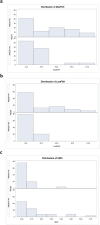Rate of rebound in follicle growth after cessation of ovarian stimulation in initial non-responders: a prospective cohort study
- PMID: 33422140
- PMCID: PMC7797149
- DOI: 10.1186/s13048-021-00765-5
Rate of rebound in follicle growth after cessation of ovarian stimulation in initial non-responders: a prospective cohort study
Abstract
Previously anecdotally observed rebounds in follicle growth after interruption of exogenous gonadotropins in absolute non-responders were the impetus for here reported study. In a prospective cohort study, we investigated 49 consecutive patients, absolutely unresponsive to maximal exogenous gonadotropin stimulation, for a so-called rebound response to ovarian stimulation. A rebound response was defined as follicle growth following complete withdrawal of exogenous gonadotropin stimulation after complete failure to respond to maximal gonadotropin stimulation over up to 5-7 days. Median age of study patients was 40.5 ± 5.1 years (range 23-52). Women with and without rebound did not differ significantly (40.0 ± 6.0 vs. 41.0 ± 7.0 years, P = 0.41), with 24 (49.0%) recording a rebound and 25 (51.0%) not. Among the former, 21 (87.5%) reached retrieval of 1-3 oocytes and 15 (30.6%) reached embryo transfer. A successful rebound in almost half of prior non-responders was an unsuspected response rate, as was retrieval of 1-3 oocytes in over half of rebounding patients. Attempting rebounds may, thus, represent another incremental step in very poor prognosis patients before giving up on utilization of autologous oocytes. Here presented findings support further investigations into the underlying physiology leading to such an unexpectedly high rebound rate.
Keywords: Failure to respond, gonadotropin isotype; Glycosylation; In vitro fertilization (IVF); Low ovarian reserve; Poor prognosis.
Conflict of interest statement
N.G., and D.H.B. are listed as co-owners of a number of already awarded and still pending U.S. patents, some claiming benefits from androgen supplementation in women with low ovarian reserve, a topic peripherally addressed in this manuscript. N.G. is a shareholder in Fertility Nutraceuticals, LLC, which produces a DHEA product, and is owner of The CHR. N.G. and D.H.B. receive patent royalties from Fertility Nutraceuticals, LLC. N.G., and D.H.B also received research support, travel funding and lecture fees from various Pharma and medical device companies, none, in any way related to this manuscript.
Figures



Similar articles
-
Conventional ovarian stimulation and single embryo transfer for IVF/ICSI. How many oocytes do we need to maximize cumulative live birth rates after utilization of all fresh and frozen embryos?Hum Reprod. 2016 Feb;31(2):370-6. doi: 10.1093/humrep/dev316. Epub 2016 Jan 2. Hum Reprod. 2016. PMID: 26724797
-
The effects of low-dose human chorionic gonadotropin combined with human menopausal gonadotropin protocol on women with hypogonadotropic hypogonadism undergoing ovarian stimulation for in vitro fertilization.Clin Endocrinol (Oxf). 2018 Jan;88(1):77-87. doi: 10.1111/cen.13481. Epub 2017 Oct 16. Clin Endocrinol (Oxf). 2018. PMID: 28960429
-
A randomized comparison of two ovarian stimulation protocols with gonadotropin-releasing hormone (GnRH) antagonist cotreatment for in vitro fertilization commencing recombinant follicle-stimulating hormone on cycle day 2 or 5 with the standard long GnRH agonist protocol.J Clin Endocrinol Metab. 2003 Jan;88(1):166-73. doi: 10.1210/jc.2002-020788. J Clin Endocrinol Metab. 2003. PMID: 12519847 Clinical Trial.
-
Androgen supplementation in IVF.Minerva Ginecol. 2013 Oct;65(5):497-504. Minerva Ginecol. 2013. PMID: 24096287 Review.
-
Insights from clinical experience in treating IVF poor responders.Reprod Biomed Online. 2018 Jan;36(1):12-19. doi: 10.1016/j.rbmo.2017.09.016. Epub 2017 Oct 24. Reprod Biomed Online. 2018. PMID: 29223475 Review.
Cited by
-
The effect of gonadotropin gap for non-growing follicles in poor ovarian response: Might this be a new strategy?Turk J Obstet Gynecol. 2024 Dec 12;21(4):266-272. doi: 10.4274/tjod.galenos.2024.71091. Turk J Obstet Gynecol. 2024. PMID: 39663777 Free PMC article.
References
-
- Albertini DF, Barad DH, Darmon S, Gleicher N, Kushnir VA. Older women using their own eggs? Issue framed with two oldest reported IVF pregnancies and a live birth. Reprod Biomed Online. 2018 Aug;37(2):172–7. - PubMed
-
- Albertini DF, Barad DH, Darmon SK, Gleicher N, Kushnir VA, Sen A, Wang Q, Weghofer A, Wu YG, Zhang L. Definition by FSH, AMH and embryo numbers of good-, intermediate- and poor-prognosis patients suggests previously unknown IVF outcome-determining factor associated with AMH. J Transl Med. 2016 Jun;10(1):172. 14(. - PMC - PubMed
MeSH terms
Grants and funding
LinkOut - more resources
Full Text Sources
Other Literature Sources
Medical

